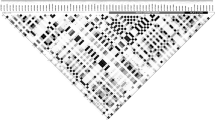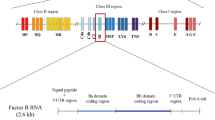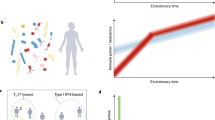Abstract
The major histocompatibility complex (MHC) is a cluster of genetic loci coding for cell surface molecules that seem to be the second most important element of the vertebrate immune system after immunoglobulins1. The MHC loci can be divided into three classes. Class I loci code for molecules of about 44,000 molecular weight (MW) which seem to function as markers of self in T-lymphocyte-mediated cytotoxicity. Class II loci code for molecules consisting of two polypeptide chains, of MW 34,000 and 28,000 respectively, which are believed to regulate the immune response by controlling the behaviour of helper and suppressor T lymphocytes. Each molecule may carry several antigens—one ‘private’ (characteristic for the allele controlling this molecule) and several ‘public’ ones2 (shared with molecules controlled by other alleles). Class III loci code for serum proteins. One of the most characteristic and remarkable properties of the MHC loci, in particular class I, is their genetic polymorphism, defined as the existence in a population of two or more alleles at appreciable frequencies3–5. In H–2, the MHC of the mouse, individual alleles at class I K and D loci occur in the two populations that have been studied thus far with an average frequency of about 2% (ref. 5). We estimate, therefore, that these two populations contain some 100 alleles at each of the two loci. The polymorphism of class II locus A seems to be somewhat lower than that of the class I loci (average allelic frequency of 2–5%), while at the second class II locus (E) only five alleles have been identified5. The polymorphism implies that a high degree of heterozygosity should exist at the MHC loci in natural populations, and this has been found at the HLA loci, the human MHC (for review see ref. 6). We report here a similarly high frequency of heterozygosity in the mouse H–2 complex in a population of mice, in spite of a social structure that would tend to reduce heterozygosity.
This is a preview of subscription content, access via your institution
Access options
Subscribe to this journal
Receive 51 print issues and online access
$199.00 per year
only $3.90 per issue
Buy this article
- Purchase on Springer Link
- Instant access to full article PDF
Prices may be subject to local taxes which are calculated during checkout
Similar content being viewed by others
References
Klein, J. Science 203, 516–521 (1979).
Klein, J. Nature 229, 635–637 (1971).
Iványi, P., Démant, P., Vojtíšková, M. & Iványi, D. Transplantn Proc. 1, 365–367 (1969).
Klein, J. Science 168, 1362–1364 (1970).
Duncan, W. R., Wakeland, E. K. & Klein, J. Immunogenetics 9, 263–274 (1979).
Snell, G. D., Dausset, J. & Nathenson, S. G. Histocompatibility (Academic, New York, 1976).
Klein, J. & Hammerberg, C. Immun. Rev. 33, 70–104 (1977).
Berry, R. J. & Peters, J. Proc. R. Soc. B197, 485–503 (1977).
Klein, J. The Biology of the Mouse Histocompatibility–2 Complex (Springer, New York, 1975).
Klein, J. & Bailey, D. W. Genetics 68, 287–297 (1971).
Author information
Authors and Affiliations
Rights and permissions
About this article
Cite this article
Duncan, W., Wakeland, E. & Klein, J. Heterozygosity of H–2 loci in wild mice. Nature 281, 603–605 (1979). https://doi.org/10.1038/281603a0
Received:
Accepted:
Published:
Issue Date:
DOI: https://doi.org/10.1038/281603a0
This article is cited by
-
Meta-populational demes constitute a reservoir for large MHC allele diversity in wild house mice (Mus musculus)
Frontiers in Zoology (2018)
-
Ancestral polymorphisms of MHC class II genes: Divergent allele advantage
Immunologic Research (1990)
-
Evolution of the immunoglobulin heavy chain variable region (Igh-V) locus in the genusMus
Immunogenetics (1989)
-
The origin of MHC class II gene polymorphism within the genus Mus
Nature (1988)
-
RFLP analysis of SLA class I genotypes in Duroc swin
Immunogenetics (1988)
Comments
By submitting a comment you agree to abide by our Terms and Community Guidelines. If you find something abusive or that does not comply with our terms or guidelines please flag it as inappropriate.



